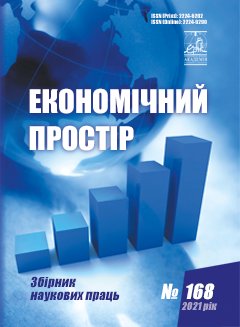ДОСЛІДЖЕННЯ СПОЖИВАЧІВ У ПРОЦЕСІ СТВОРЕННЯ ТА РОЗПОВСЮДЖЕННЯ ІННОВАЦІЙНИХ ТОВАРІВ
Анотація
Розглянуто мотиваційну інноваційність споживачів у процесі створення та розповсюдження інноваційних товарів. Досліджено процес визначення споживчих переваг інноваційного товару на основі його атрибутів. Розроблено механізм процесу відбору цільової аудиторії для формування комплексу маркетингових комунікацій з урахуванням мотивації споживачів. Одним зі шляхів підтримання конкурентоспроможності підприємства, освоєння нових сегментів ринку є виведення інноваційних товарів. Цей процес завжди є достатньо ризиковим, навіть коли інноваційний товар має очевидні переваги для споживачів. Результати багатьох досліджень показали, що понад 30% товарів споживчого попиту і приблизно 20% товарів промислового призначення зазнають ринкових невдач. Пояснюється це тим, що інноваційні товари створюються переважно тільки на базі нових знань без урахування реальних потреб ринку. За цих умов ключовим чинником ринкового успіху товару є маркетингові дослідження споживачів на етапі створення інноваційного товару.
Посилання
Woodside A.G., Sheth J.N., Bennett P.D. Psychographics and buyer behavior: theory and recent empirical findings. Consumer and Industrial Buying behaviour. New York : Elsevier North Holland, 1977. P. 601–612.
Tucker W., Painter J. Personality and product use. Journal of Applied Psychology. 1961. № 45. Р. 325–329.
Hill R., Stamey M. The homeless in America: an examination of possessions and consumption behaviors. Journal of Product Consumer Research. 1990. № 17. Р. 303–321.
Rossister J.R., Percy L. Emotions and motivations in advertising. Advances in Consumer Research. 1991. № 18. Р. 7–44.
Simonson I., Nowlis S.M. The role of explanations and need for uniqueness in consumer decision making: Unconventional choices based on reasons. Journal of Consumer Research. 2000. № 27(1). Р. 49–68.
Cooper R.G. Winning at new products. Journal of Product Innovation Management. 1986. № 3. Р. 307–308.
Stephen M. Nowlis, Ravi Dhar, Itamar S. The Effect of Decision Order on Purchase Quantity Decisions. Journal of Marketing Research. 2010 № 47(4). Р. 725–737.
Goldsmith R.E., Hofacker C.F. Measuring consumer innovativeness. Journal of the Academy of Marketing Science. 1991. № 19(3). Р. 209–221.
Daghfous N., Petrof J.V., Pons F. Values and Adoption of Innovations: a Cross-Cultural Study. Journal of Consumer Marketing. 1999. № 16(4/5). Р. 314–331.
Woodside A.G., Sheth J.N., Bennett P.D. (1977) Psychographics and buyer behavior: theory and recent empirical findings. Consumer and Industrial Buying behaviour’. New York: Elsevier North Holland, 601–612.
Tucker W., Painter J. (1961) Personality and product use. Journal of Applied Psychology, 45, 325–329.
Hill R., Stamey M. (1990) The homeless in America: an examination of possessions and consumption behaviors. Journal of Product Consumer Research, 17, 303–321.
Rossister J.R., Percy L. (1991) Emotions and motivations in advertising. Advances in Consumer Research, 18, 7–44.
Simonson I., Nowlis S.M. (2000) The role of explanations and need for uniqueness in consumer decision making: Unconven¬tional choices based on reasons. Journal of Consumer Research, 27(1), 49–68.
Cooper R.G. (1986) Winning at new products. Journal of Product Innovation Management, 3, 307–308.
Stephen M. Nowlis, Ravi Dhar, Itamar S. (2010) The Effect of Decision Order on Purchase Quantity Decisions. Journal of Marketing Research, 47(4), 725–737.
Goldsmith R.E., Hofacker C.F. (1991) Measuring consumer innovativeness. Journal of the Academy of Marketing Science, 19(3), 209–221.
Daghfous N., Petrof J. V., Pons F. (1999) Values and Adoption of Innovations: a Cross-Cultural Study. Journal of Consumer Marketing, 16(4/5), 314–331.



